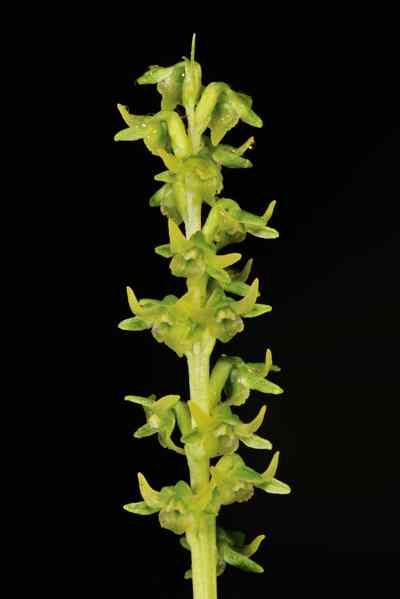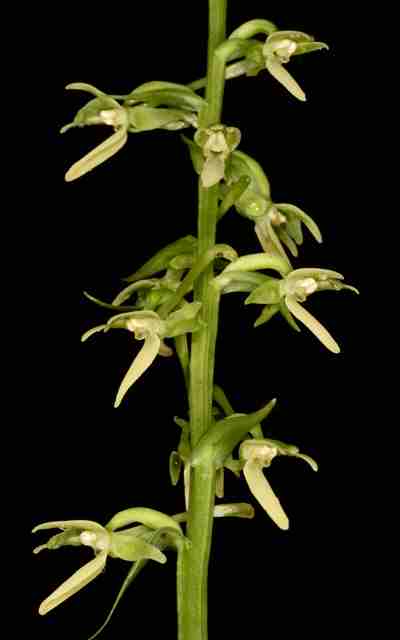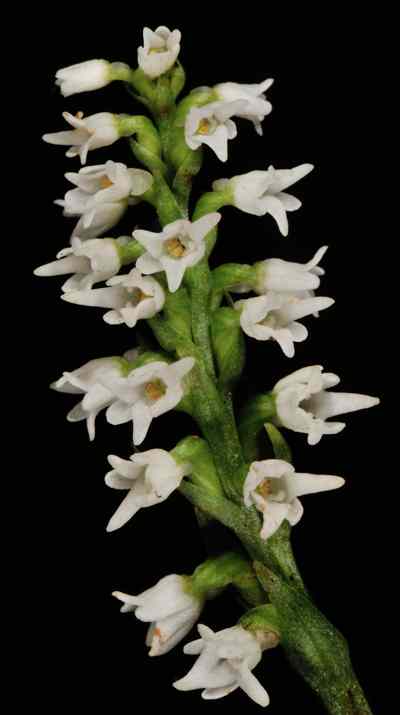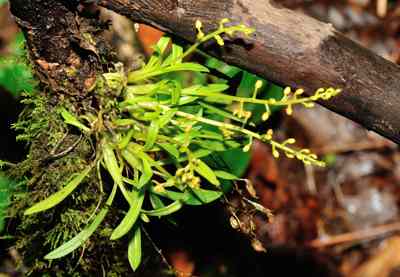The Plant
Terrestrial. Whole plant 5 to 7 cm in height. Tuber solitary, ovate, 1 to 1.2 cm long and less than 1 cm in cross section, with 2 to 3 fleshy stout around 2 to 3 cm long roots and a few fibrous roots attached to it. Stem cylindrical, fleshy and more than half the length of the whole plant, its base with two long clasping oblong sheaths with the upper one with wide mouth, both 1 to 1.4 cm long. Leaf two arising from the apex of the stem, sub-opposite, lanceolate to ovate – closer to the latter, sessile, narrowing towards its base to a clasping base, 2.7 to 4.5 cm long and 1.4 to 1.7 cm wide. Flower solitary arising from the apex of a narrow cylindrical and ribbed scape shorter than the stem.
The Flower
Flower around 2.5 cm across. Sepals un-equal, ovate, margins towards the apex slightly curved up to form a minutely keeled apex. Dorsal larger than the lateral sepals, erect, 1.2 to 1.5 cm long and less than 0.7 to 0.8 cm wide. Lateral sepals shorter and narrow than the dorsal, spreading. Petals erect, slightly shorter than the lateral sepals, obdeltoid in outline with straight and narrowing to the base margins, base broad. Lip deeply three lobed, diverging towards its apex, lobes with straight and narrowing to the apex margins, 0.3 to 0.4 cm wide at its base and 0.2 to 0.3 cm wide at its apex, the middle one wider and longer than the side lobes. Spur small, cylindrical to globose, minutely curved towards its apex, 0.3 cm long. Floral bract very small, 0.4 to 0.5 cm long, erect, clasping and arising from the upper base of the erect and arching ovary.
Sepals shinning green with silvery white reticulations throughout, margins white. Petals pale cream to pale yellowish with a broad pale green patch running from its base to the middle. Lobes of the lip white to pale cream, mouth of the spur pale green. Floral bract green.
Note: The discovery of Bhutanthera albovirens Renz., from the region of Sikkim-Himalayas was the first of its kind. Until its discovery in 2012 in Sikkim-Himalayas, this species was believed to be endemic to Bhutan.
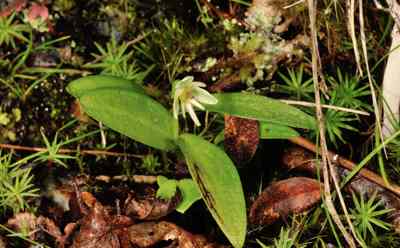
The Pursuit
Till its discovery, this species was considered endemic to Bhutan and reported only a couple of times. Interestingly, I was totally unaware about such a species. Later on during my research on the species I found out that a Japanese botanist photographed the species from the high hills of Bhutan and that is the only photographic evidence of the species till the time I found it.
It was my first Alpine flower hunt season and I was really happy to have succeeded in locating more than 55 alpine orchid species. Many of those species were rediscoveries after they found mention in the monumental work of Sir. George King and Robert Pantling 120 years back. In the last month of the flowering season, I was concentrating on altitudes above 14000 ft. The blooming pattern of flowers in the Himalayas is very interesting; it starts from the lower altitudes by the early summer and moves higher and higher. By the last of the season it reaches the highest meadows, which shares border with the permanent snow line.
As most of the species I was looking for were discovered I was in a relaxed mood in those days. Still kept my routine field study intact looking for more species. In the Himalayas every other day brings surprises with many new finds, hence I was hopeful of something new.
I was on a high mountain on that day; I searched that location many times during several of my previous visits. Around half the height of the mountain there were large rocks, which were full of moss cover and with many small plants growing on it. Every time when I visited that area I always spent considerable time observing those small plants on those rocks with eagerness. On that day too, I spent considerable time studying many plants from there. As I was about to move out to the higher side, my attention was drawn towards a small plant with a solitary flower. On close observation I found that there were four plants growing close to each other with two of them in flower. As the plants where on the lower side of the rock with many thorny bushes around, it was very difficult to reach it. Slowly I removed those thorny bushes and bend down to have a closer look. With its three lobed lips I instantly identified it as a species from the genus Bhutanthera. I was really overjoyed with its find, as I know there are no reports of any other Bhutanthera species other than the one reported earlier. However, to be frank, I was not able to identify the species at that moment. As it was only a couple of plants in bloom I took absolute care to document the plants and its flower without even disturbing its habitat. At those altitudes with high winds and thorny bushes around, it was very difficult to produce the desired documentary results I was in need. With my experience of working on those altitudes coming handy, I managed to produce some amazing documentary results of the species, but with great difficulty.
I still remember that evening like yesterday, the excitement it created after seeing those documentary evidence on my laptop. Then it took a couple of days of research to confirm its identity properly with help from abroad. The confirmation of the species identity was one more feather to my cap, as this is the first time the species was reported outside Bhutan.
Reference:
Bhutanthera albovirens Renz., is a new report to the region. This species was not reported from the region till date and was believed to be endemic to Bhutan only.



